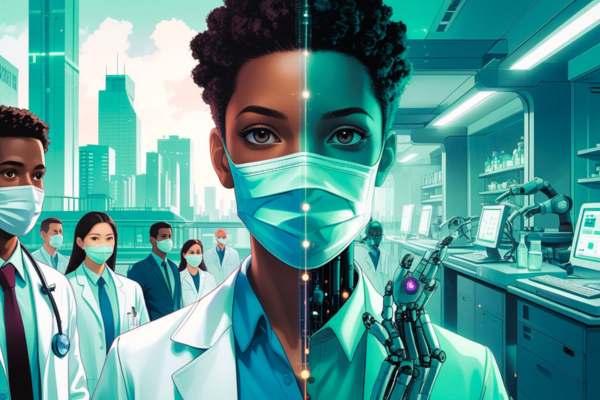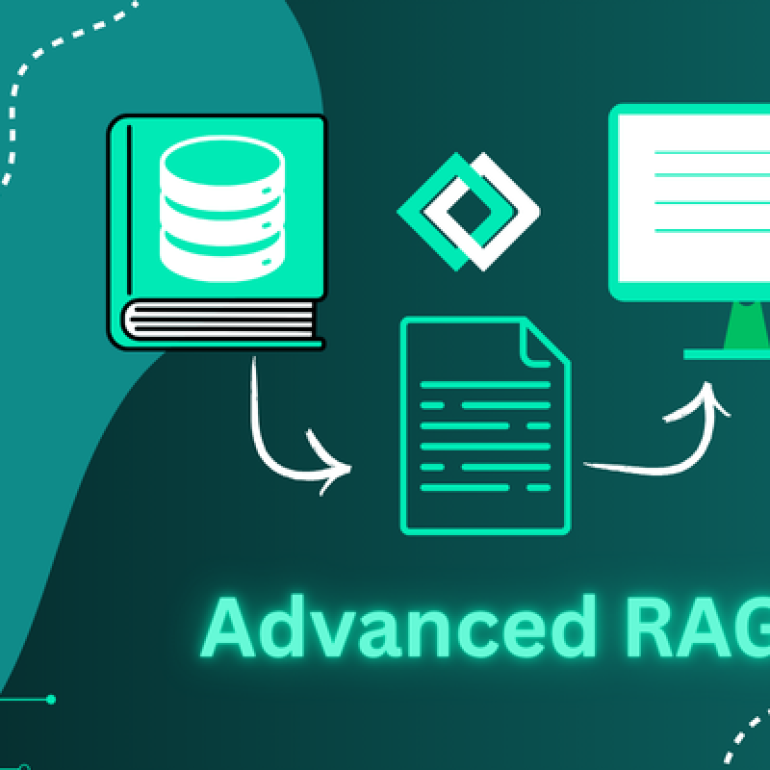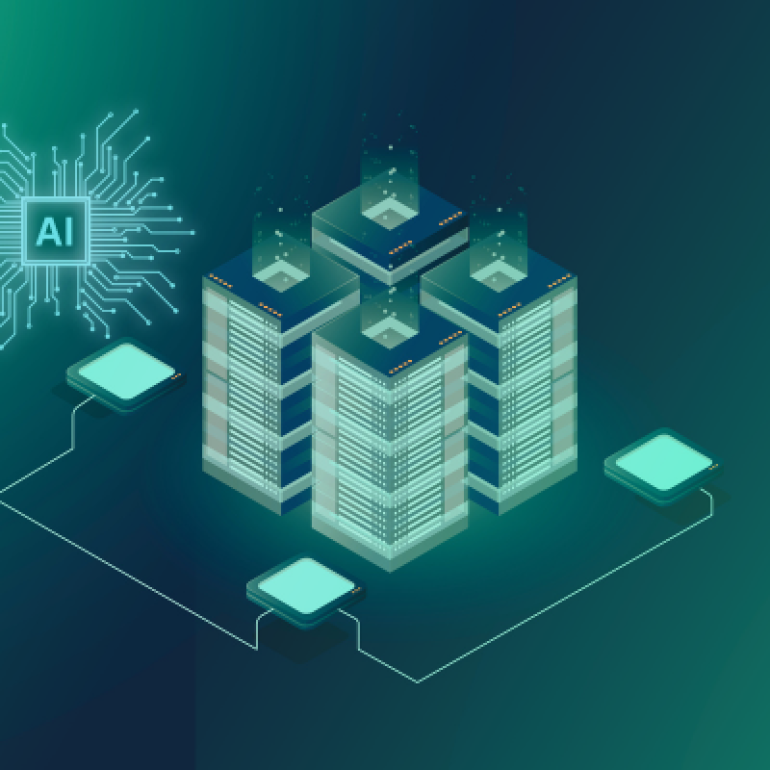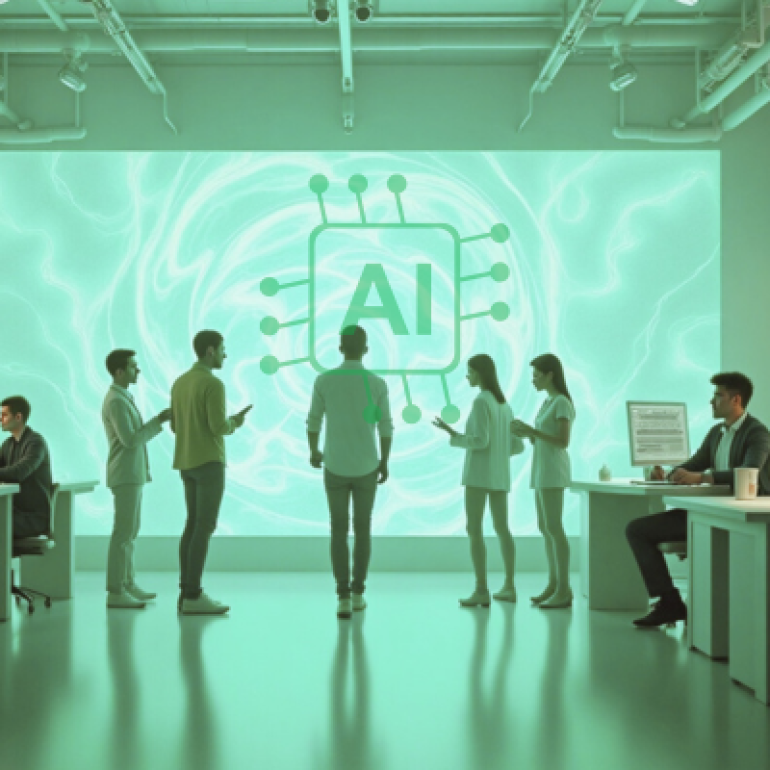- 7 July 2025
- Dr. Chandra Bondugula
Can AI Predict and Prevent the Next Pandemic
In an era marked by unpredictable health threats, artificial intelligence (AI) has emerged as a game-changing ally in the fight against future pandemics. From identifying outbreaks before they occur to accelerating vaccine development, AI’s potential in global health security is rapidly evolving.

Introduction
In an era marked by unpredictable health threats, artificial intelligence (AI) has emerged as a game-changing ally in the fight against future pandemics. From identifying outbreaks before they occur to accelerating vaccine development, AI’s potential in global health security is rapidly evolving. With the memory of COVID-19 still fresh, the urgency to harness cutting-edge technologies to prevent another catastrophe has never been greater.
But can AI really predict and prevent the next pandemic?
This blog dives deep into the science, real-world applications, and potential challenges of AI in forecasting and mitigating future global health crises.
Why Does the World Need Better Pandemic Prediction Tools?
The COVID-19 pandemic showed us how unprepared the world was. Hospitals overflowed, global travel stopped, and millions of lives were lost. According to the WHO, over 6.9 million people died from COVID-19 by 2023. Many of those deaths could have been prevented with faster action.
New diseases are now emerging more often, often jumping from animals to humans. This is due to:
- Deforestation, which increases human-animal contact
- Global travel, spreading diseases quickly
- Climate change, changing the habitats of disease-carrying animals
Pandemics are no longer rare events. Experts warn that without better detection, we could face more outbreaks in the future.
This is where AI becomes crucial. It can analyze data in real-time, spot early warning signs, and even predict where a new outbreak may start. AI helps us act early—before it’s too late.
In today’s connected world, early detection saves lives, and AI gives us a powerful tool to do just that.
How Can AI Predict the Next Pandemic?
Artificial Intelligence (AI) is rapidly changing the way we approach global health. When it comes to predicting future pandemics, AI isn’t just useful—it’s potentially life-saving.
So, how exactly does AI help predict the next pandemic? Here’s a breakdown:
I. Analyzing Massive Health Data in Real Time
AI can process huge volumes of health data from around the world—far faster than any human could. This includes:
- Disease outbreak reports
- Travel data
- Hospital admissions
- Animal and environmental data
- Social media trends and news alerts
By analyzing this information in real time, AI can spot unusual patterns and detect early signals of a new outbreak before it becomes widespread.
According to a 2025 study from the University of Florida, AI models can now track and analyze data with greater speed and accuracy, helping public health officials act faster and smarter. Source
II. Identifying Hotspots and High-Risk Regions
AI doesn’t just predict “that” a disease may emerge—it also predicts “where”. Using geospatial modeling and predictive analytics, AI can highlight high-risk areas based on:
- Population density
- Wildlife-human interaction
- Climate conditions
- Previous outbreak patterns
This enables governments and health agencies to focus their surveillance and resources before an outbreak spreads.
The University of Oxford highlights in a 2025 study that AI tools are now capable of mapping out pandemic risks by learning from past outbreaks and environmental factors. Source
III. Predicting Pathogen Evolution and Transmission
Modern AI models can also predict how viruses might mutate, spread, and affect different populations. By feeding AI tools with genomic data, researchers can:
- Simulate how a virus might evolve
- Estimate the rate of transmission
- Forecast severity and healthcare impact
This helps scientists stay one step ahead of the next viral threat, potentially developing vaccines or treatments before the outbreak hits.
As reported in News-Medical, “AI has significantly improved our ability to forecast pathogen emergence and transmissibility.” Source
IV. Detecting Early Warning Signs from Non-Traditional Sources
AI doesn’t just rely on official reports. It also scans non-traditional data sources like:
- Internet search queries
- Online news and blogs
- Social media posts (e.g., sudden spikes in “fever” or “cough” mentions)
This allows AI systems to detect early public concerns and local symptoms even before cases are formally reported.
Tulane University’s School of Science and Engineering notes, “AI surveillance tools are now capable of mining global data sources to identify early outbreak indicators before clinical confirmation.” Source
What Are the Key Factors That Make AI Effective in Predicting Pandemics?
Artificial Intelligence holds great promise in predicting and preventing future pandemics—but its success depends on several critical factors. Simply having powerful algorithms isn’t enough. To make AI truly effective for pandemic prediction, the right conditions, data, and collaboration must be in place.
Let’s break down the key elements that empower AI to detect outbreaks before they spiral out of control:
I. Access to High-Quality, Real-Time Data
AI models are only as good as the data they learn from. For pandemic prediction, this includes:
- Epidemiological data (infection rates, hospital admissions)
- Environmental and climate data (temperature, humidity, pollution)
- Travel and mobility data (flight patterns, migration trends)
- Animal health data (zoonotic disease trends)
When this data is accurate, updated frequently, and openly shared, AI systems can recognize emerging threats faster and with higher accuracy.
As noted by News-Medical.net, “AI-driven modeling success hinges on data accessibility.” Without transparent and comprehensive data streams, even the best AI tools fall short. Source
II. Advanced Machine Learning Algorithms
Machine learning (ML) is a subset of AI that enables systems to learn from data patterns. For predicting pandemics, ML models are trained on historical outbreaks to:
- Identify signs of disease emergence
- Spot anomalies in real-time data feeds
- Forecast future transmission patterns
These models improve over time, especially when supported by neural networks, deep learning, and natural language processing (NLP) to scan both structured and unstructured data.
III. Global Collaboration and Data Sharing
AI can’t predict pandemics in isolation. It requires collaboration between governments, research institutions, and healthcare organizations to:
- Share outbreak reports and health data
- Build unified databases
- Ensure data privacy and ethical use
According to the University of Oxford’s 2025 study, AI will be more powerful when countries work together to “share data from human, animal, and environmental sources.” Source
IV. Interdisciplinary Expertise
Pandemics are not just medical issues—they’re also social, economic, and environmental. That’s why AI development must involve:
- Epidemiologists and public health experts
- Data scientists and AI engineers
- Environmental scientists and wildlife researchers
When these experts work together, AI models become more holistic, reliable, and actionable.
V. Ethical AI and Transparent Algorithms
Finally, for AI to gain global trust, it must be transparent and ethical. This means:
- Ensuring AI decisions are explainable
- Avoiding algorithmic bias
- Protecting user data and privacy
Building trust is crucial, especially when AI is influencing public health decisions that affect millions.
Can AI Really Prevent the Next Pandemic?
I. Early Intervention Through Real-Time Alerts
One of AI’s most powerful advantages is its ability to send out alerts weeks before an outbreak reaches its peak. For example:
- BlueDot flagged COVID-19 on December 31, 2019
- HealthMap and MetaBiota also raised alarms early
These alerts allow governments and health agencies to:
- Mobilize resources
- Set up quarantine zones
- Begin vaccine development early
II. AI in Vaccine and Drug Discovery
AI accelerates the drug discovery process, which traditionally takes years. It does this by:
- Screening millions of compounds quickly
- Predicting how a virus might mutate
- Modeling drug-virus interactions
As highlighted in Tulane University’s article, “AI was used to identify molecular targets and accelerate vaccine development against SARS-CoV-2.”
Success Stories: How AI Helped During COVID-19
1. BlueDot’s Early Warning
BlueDot used AI to analyze data from airlines, news reports, and health organizations. It flagged COVID-19 nine days before the WHO issued a global alert.
2. AI in Genomic Sequencing
Machine learning tools helped track mutations of the SARS-CoV-2 virus, aiding in the development of vaccines and monitoring for new variants.
What Are the Challenges of Using AI to Prevent the Next Pandemic?
While AI has the potential to revolutionize pandemic prediction, it’s not a silver bullet. There are still several challenges that limit the full effectiveness of AI in public health, especially when it comes to preventing the next global outbreak. These barriers must be addressed to ensure AI becomes a dependable and ethical tool in safeguarding global health.
Here are the key challenges:
I. Lack of Standardized and Accessible Health Data
One of the biggest hurdles is data fragmentation. Health data is often:
- Collected in different formats
- Stored in separate silos
- Governed by various privacy laws across countries
This makes it difficult for AI systems to access real-time, unified datasets, which are essential for accurate forecasting.
As emphasized in News-Medical.net, “The success of AI-driven modeling hinges on data accessibility.” Without global data sharing, AI’s ability to detect outbreaks early is significantly reduced. Source
II. Bias in Algorithms and Data Sets
AI tools are trained on historical data. If that data is biased or incomplete, the predictions will be too. For instance:
- Underserved regions may have limited health data
- Low-income countries may be underrepresented
- AI models may miss early warning signs in marginalized populations
This can result in unequal surveillance, where certain outbreaks go unnoticed until it’s too late.
III. Limited Global Collaboration
AI thrives on international data exchange, but unfortunately, many countries are hesitant to share sensitive health data due to:
- National security concerns
- Lack of infrastructure
- Political or economic interests
This lack of transparency and cooperation slows down the speed at which AI can identify global threats.
The University of Oxford highlights that global collaboration is essential for AI to reach its full potential in pandemic preparedness. Source
IV. High Cost of Implementation
Developing and maintaining sophisticated AI systems requires:
- Skilled data scientists and AI engineers
- High-performance computing infrastructure
- Continuous training and data updates
These financial and technical resources are not always available, especially in low- and middle-income countries where pandemic surveillance is needed the most.
V. Ethical and Privacy ConcernsOutbreaks
AI systems often need access to personal health data, travel patterns, and even location tracking. This raises valid concerns around:
- Patient privacy
- Data misuse
- Consent and transparency
To gain public trust, AI in healthcare must be ethical, transparent, and secure.
VI. Difficulty in Predicting Novel Pathogens
AI excels at detecting patterns in known data, but struggles when faced with completely new pathogens that have no historical precedent. While it may identify symptoms or case spikes, it can’t always predict the exact nature or behavior of an entirely new virus
How Is AI Preparing Us for Future Outbreaks?
As the world reflects on the lessons from COVID-19 and past pandemics, one thing has become crystal clear: early detection and rapid response are the keys to saving lives. Artificial Intelligence is stepping up as a game-changer in making that possible. But how exactly is AI preparing us for future outbreaks? Let’s break it down.
I. Creating Early Warning Systems for Emerging Diseases
AI is powering real-time surveillance platforms that monitor disease activity across the globe. These AI-driven early warning systems can detect signs of unusual illness clusters even before formal reports surface.
- BlueDot, for instance, flagged early signs of COVID-19 days before the WHO issued its first statement.
- AI tools can now scan news outlets, social media chatter, flight data, and hospital reports to look for early outbreak signals.
As reported by Tulane University, “AI can analyze thousands of data points across digital platforms and alert authorities before a full-blown outbreak occurs.” Source
II. Enhancing Global Disease Surveillance
AI is transforming how we track, monitor, and respond to infectious diseases. With the help of AI:
- Governments and health organizations can track outbreaks in real time.
- AI models integrate cross-border data, helping to coordinate responses between regions.
- Tools like HealthMap use machine learning to generate live maps of emerging threats.
This level of global disease surveillance using AI ensures that no region is left behind, even those with limited healthcare infrastructure.
III. Accelerating Vaccine and Drug Discovery
AI is also revolutionizing the pharmaceutical and biotech industries. During COVID-19, AI helped researchers:
- Identify potential antiviral compounds
- Analyze protein structures of the virus
- Predict how mutations might impact drug effectiveness
By using AI to speed up simulations and predictions, scientists can develop vaccines and treatments faster than ever before, drastically shortening the response time during pandemics.
The University of Florida states that AI is now a critical part of public health preparedness strategies, from modeling virus behavior to guiding vaccine development. Source
IV. Simulating Outbreak Scenarios for Better Planning
AI tools are now used to simulate pandemic scenarios based on various factors like:
- Transmission rates
- Population mobility
- Hospital capacity
- Policy responses (like lockdowns or travel bans)
These simulations help public health agencies and governments prepare for worst-case scenarios, allocate resources wisely, and establish effective emergency response protocols.
V. Improving Communication and Risk Awareness
AI-powered platforms can also assist in disseminating reliable public health information by:
- Flagging misinformation online
- Creating personalized alerts for at-risk populations
- Translating and distributing health advisories in multiple languages
By improving risk communication, AI helps reduce panic, misinformation, and delayed action during outbreaks.
Using AI to Predict, Prevent, and Control Global Pandemics
Artificial Intelligence is rapidly transforming the way we respond to global health threats. But what makes AI such a powerful tool in preventing the next pandemic? The answer lies in its unique ability to analyze massive data sets, detect patterns, and forecast future events faster than any human or traditional system ever could.
Let’s explore the features that make AI indispensable for pandemic preparedness:
I. Speed and Scale of Data Processing
During the early stages of an outbreak, time is everything. Delays in identifying and responding to a new virus can mean the difference between local containment and a global crisis. This is where AI shines.
- AI can analyze millions of data points in seconds—from social media posts and news articles to clinical records and environmental reports.
- Traditional surveillance systems may take weeks to recognize a threat. AI does it in near real time.
As noted by BBC News, “AI platforms are capable of monitoring and flagging health anomalies globally, providing critical lead time before diseases spread widely.” Source
II. Pattern Recognition Across Complex Systems
Pandemics don’t arise from a single source—they’re the result of complex interactions between humans, animals, climate, and environment. AI uses pattern recognition to connect the dots across diverse data types like:
- Climate changes linked to mosquito-borne diseases
- Deforestation increasing human-animal contact
- Migration and air travel contributing to faster transmission
AI can detect subtle patterns and correlations that would be impossible to spot manually, helping predict where the next outbreak could begin.
III. Predictive Modeling for Future Threats
One of AI’s most valuable contributions is forecasting. Using machine learning, AI models are trained on:
- Historical pandemic data
- Viral mutation trends
- Population health behaviors
- Medical supply chain vulnerabilities
These inputs allow AI to simulate possible future scenarios and offer actionable insights like:
- Where resources should be allocated
- Which regions are high-risk
- How policies might affect transmission
This makes AI a strategic tool not only in response but in proactive risk reduction.
IV. 24/7 Disease Surveillance and Monitoring
Unlike human-led monitoring systems that may operate on limited schedules, AI-powered tools are always on:
- Monitoring global health alerts from WHO and CDC
- Scanning news from hundreds of countries in real time
- Tracking changes in virus behavior or new symptoms
According to News-Medical.net, “Advances in AI-driven modeling allow continuous scanning for signs of pathogenic emergence and transmissibility.” Source
This 24/7 vigilance ensures no critical warning signs are missed, even in remote or underserved areas.
V. Automated Contact Tracing and Case Management
AI is not just about prediction—it’s also about streamlining pandemic response. One important role is in automated contact tracing, which helps:
- Identify people exposed to an infected individual
- Notify contacts instantly
- Prevent further transmission without overwhelming human resources
In addition, AI assists with case prioritization, helping healthcare providers focus on high-risk individuals first and manage hospital resources more effectively.
VI. Adaptability to Novel Pathogens
Even when a brand-new virus emerges—like SARS-CoV-2—AI can:
- Rapidly analyze its genome
- Compare it with similar viruses
- Help researchers understand how it spreads
This speed enables faster vaccine and treatment development, giving the world a better fighting chance.
The University of Florida emphasizes, “AI is crucial for understanding the genetic and behavioral makeup of unknown pathogens as they emerge.” Source
What Exactly Is AI Doing to Predict and Prevent the Next Pandemic?
Artificial Intelligence is no longer just a futuristic concept—it’s already reshaping how we monitor, predict, and prevent infectious disease outbreaks across the globe. But what is AI actually doing behind the scenes? How does it convert raw data into life-saving insights?
Let’s dive into the core ways AI is actively working to protect us from the next global health crisis.
I. Analyzing Vast, Multi-Source Health Data in Real Time
AI algorithms can collect and process data from a wide range of sources, including:
- Electronic Health Records (EHRs)
- Social media and news feeds
- Environmental and climate data
- International flight logs and travel data
- Laboratory research and genomics
This integration of structured and unstructured data allows AI to track disease patterns in real time and spot anomalies before humans can.
As noted by News-Medical.net, “Advances in AI-driven modeling can detect early signals of pathogenic emergence and transmissibility.” Source
II. Identifying Hotspots Before They Become Outbreaks
AI doesn’t wait for outbreaks to happen. It’s trained to predict areas at high risk by evaluating:
- Population density
- Vaccination rates
- Local healthcare infrastructure
- Wildlife-human interaction zones
- Historical outbreak data
For example, if AI detects unusual spikes in flu-like symptoms in a dense urban area with poor medical access, it can alert health authorities before the situation escalates.
III. Spotting New and Emerging Pathogens Faster
AI systems use machine learning to compare genetic sequences of viruses and bacteria. They help researchers:
- Detect new strains
- Understand mutation patterns
- Predict how these changes might affect transmission or severity
This is particularly crucial for “Disease X” scenarios—the World Health Organization’s term for the unknown pathogen that could cause the next pandemic.
The University of Oxford explains that AI can map the emergence of potential pandemic threats long before symptoms appear in large populations. Source
IV. Monitoring Global Travel and Mobility Patterns
In our hyperconnected world, viruses can cross borders in hours. AI models trained on real-time flight, travel, and migration data can:
- Track how people move across countries and continents
- Simulate how fast a virus could spread
- Inform travel advisories and restrictions
This function was used during the early stages of COVID-19, where tools like BlueDot were among the first to sound the alarm using air travel data and media analysis.
V. Supporting Governments and Public Health Agencies with Decision-Making
AI systems are also being used by governments and health agencies to:
- Run outbreak simulations
- Predict hospital surge capacity
- Allocate vaccines and supplies efficiently
- Evaluate policy decisions like lockdowns and reopenings
This kind of decision support is vital during the critical early days of an outbreak, when every choice has a high-stakes impact on public health.
VI. Helping to Identify and Counteract Misinformation
AI is increasingly used to:
- Flag false health claims online
- Promote verified information through chatbots and mobile alerts
- Provide multilingual, accessible updates in real time
During pandemics, misinformation spreads faster than the virus itself. AI tools help authorities keep public communication accurate, clear, and timely.
Conclusion:
Can AI Be the Ultimate Shield Against the Next Pandemic?
The answer is a confident yes—but with a few critical caveats. AI is not a crystal ball, but it’s the most powerful tool we have today to detect, predict, and prevent pandemics with unprecedented accuracy and speed.
From early detection of unknown pathogens to real-time disease surveillance, predictive modeling, and supporting public health decisions, artificial intelligence is reshaping how we safeguard global health. However, its effectiveness hinges on access to reliable data, cross-sector collaboration, and ethical deployment.
As highlighted by Tulane University, “AI’s potential to mitigate future pandemics is enormous—but its success depends on transparency, data equity, and responsible use.” Source
At the forefront of AI-driven healthcare innovation, SHC Technologies continues to develop intelligent solutions that empower health organizations to stay ahead of emerging threats. By combining advanced analytics, machine learning, and scalable infrastructure, SHC Technologies is committed to helping the world prepare better for the next health crisis—before it spirals out of control.




